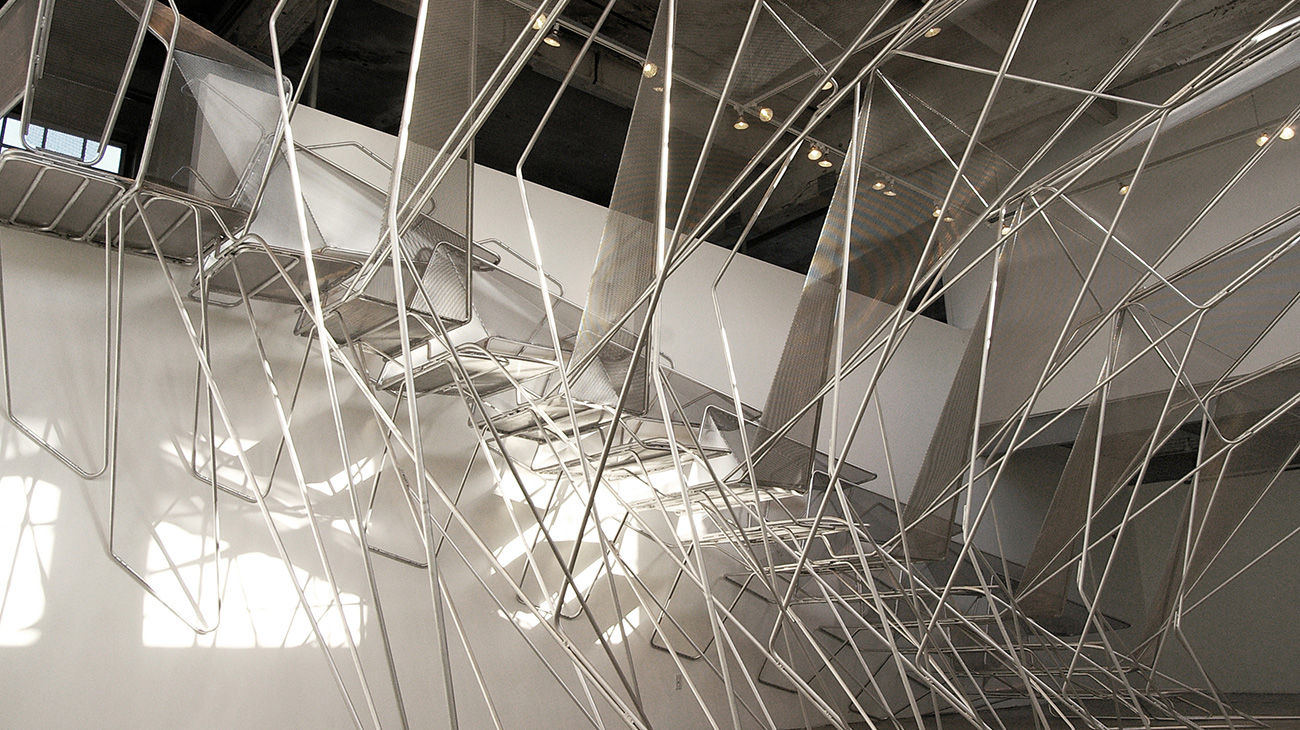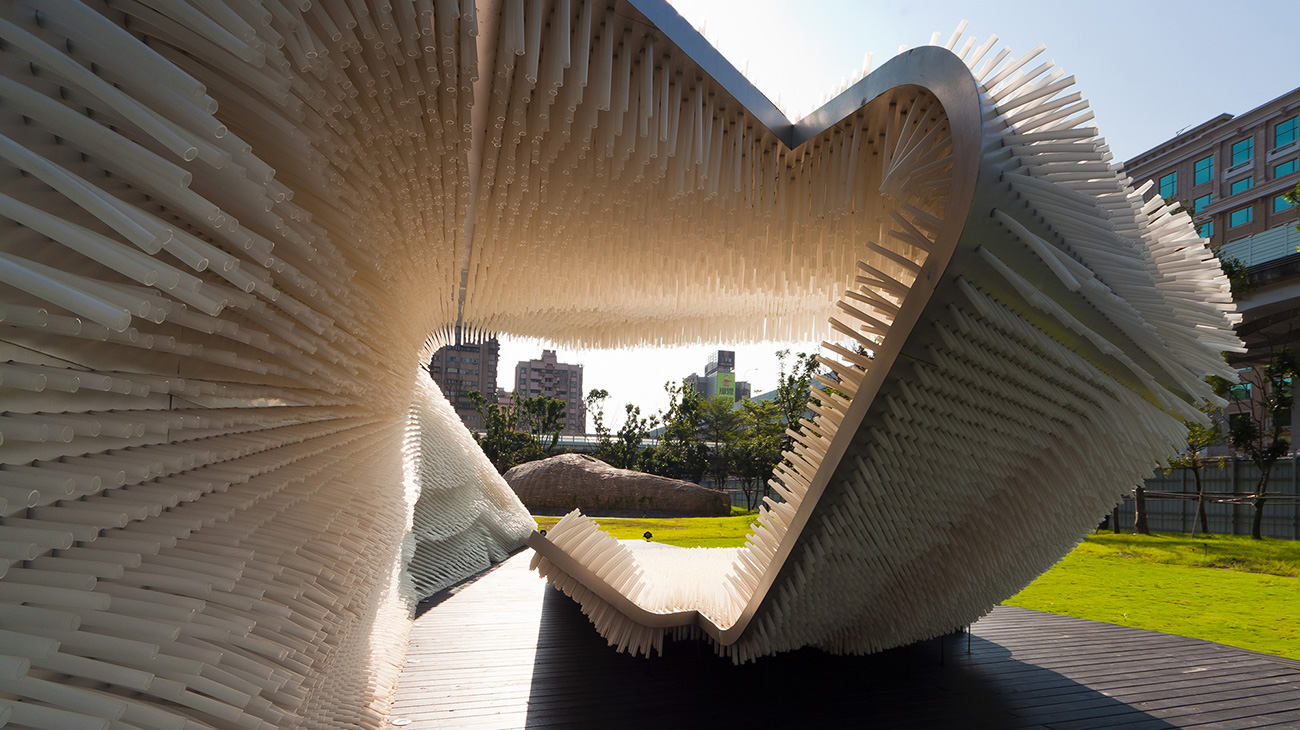Oyler Wu Collaborative interview
Dwayne Oyler and Jenny Wu of Oyler Wu Collaborative discuss their various projects.
An interview with Oyler Wu Collaborative, a 2012 Emerging Voice.
Most of Oyler Wu Collaborative’s projects are self-built, providing the opportunity for “the design process to continually respond to the feedback provided by the fabrication process.” In addition to speculative façade designs, over the past year the office has built Anemone, a pavilion in Taipei; a traveling installation “reALIze” (in collaboration with Michael Kalish); and “Netscape,” a large steel-framed and knitted rope canopy at SCI-Arc, which was designed and constructed with students. Based in Los Angeles, the firm is led by Dwayne Oyler and Jenny Wu.
Dwayne Oyler and Jenny Wu sat down to discuss their work and what it means to be an Emerging Voice with Anne Rieselbach, the League’s Program Director.
*
Anne Rieselbach: This series emphasizes the voice of the practitioners: how would you describe your voice?
Dwayne Oyler: I can think of two different ways of talking about it. One has to do with the content of the practice: this constant investigation of ideas related to line work. Trying to make line work do more than it has specifically been asked to do—we’re interested in experiential ideas of the line, or how to get a dynamic reading out of the piece. Not so much from a typical engineering standpoint, but the idea that the work can be enriched experientially when the structural complexity is lending itself to the structural performance of the piece.
Jenny Wu: And also the geometric build-up of lines, aggregating smaller elements to a bigger form.
Oyler: Yeah, and if you look at the work, even though it’s dealing with line, it’s almost never two-dimensional. We’re not really interested in line as a graphic, so much as a spatial problem.
The second way of talking about voice, has to do with our working method: the way we address the same set of ideas by building out the forms, over and over again. Unlike when we first got out of school, when we thought we had to start completely over after each project, now we’re trying to really learn from the fabrication. Build and rebuild and rebuild.
Wu: I think unlike a lot of architects, especially in our generation, our process is very messy. We don’t adhere to one technique, one method, one fabrication process. We’re very much about using everything that’s available to us and making it happen.
Rieselbach: You’ve described the importance of developing a body of work as a means of slowly accumulating and incorporating with a growing range of issues. Could you talk about your experience in moving from small scale installations to larger scale pieces and how that’s affected your development as a practice?
Wu: To get back to what Dwayne was just saying, when we first got out of school about ten years ago, the first five years we entered a lot of competitions. And we thought, “this is the way we’re going to get a project.” But we were even more dissatisfied with the process than with the results of the competitions (which we mostly lost). We felt like we were dabbling in a lot of unrelated ideas, more importantly, we weren’t learning from one to the next. So we decided, no more competitions: we’re going to invent our own projects, and we’re going to try to build them. And so this is when we launched into aluminum—we did about four of the aluminum tubing based projects.
Rieselbach: The Woodbury University installation was the first one?
Wu: That was the second one. We did the first one for Materials and Applications, then Woodbury, the Sci-Arc Gallery stair project, and finally the collaboration with Michael Kalish we did on the Muhammad Ali tribute project. And from completing those projects we have learned a lot about the material—we’re very comfortable with it now, so it may be time to move on.
Oyler: The work has definitely been getting much larger, within the last two years especially. The Taipei towers were a huge leap for us; to answer your question, we’ve had to really change our thinking about what some of those ideas related to line can do. In retrospect, at that kind of scale, the same ideas don’t work as well. Working within the considerable restrictions of the floorplan, our complex ideas about line turned into mere skin experiments.
Wu: We did about five different 16-story buildings before we got one that’s going to be built, and through that process we learned something about how you jump scales. Can a line that we used to do an installation be a line that becomes the façade of a building? We’re definitely realizing it’s not a one-to-one correlation. You just can’t blow something up.
Oyler: Structurally it doesn’t work either—it’s a superficial approach.
Wu: But we’re definitiely learning about jumping scales.
Rieselbach: Can you tell me how the iterative experimentation, the slight variations on a single technique, play out for you in this development?
Oyler: One of the other reasons we don’t do competitions anymore is because we realized that the kind of work we do does not render well. I mean, so much of the work has to do with seeing it in the light, or in the way people touch or interact with it—it is very, very difficult to get the sparkle of aluminum using rendering techniques. And yet, that aspect was absolutely key to our pieces in the end, and certainly affected how they were experienced.
So I think that this kind of physical, iterative experimentation we’re doing has allowed us to get inside of the work, and therefore to really understand it. It’s allowed us, for example, to make decisions about whether a joint should be a bend, or a cut and weld, or a sanded orbital. They sound like relatively trivial ideas, but they dramatically change the work, and I think that had we not gone through the process of working with it in a very intimate and hands-on way, it would have produced drastically different results.

Oliver Wu Collaborative | Live Wire, SCI-Arc Gallery Installation, Los Angeles, CA, 2008. Image courtesy Oyler Wu Collaborative
Rieselbach: What were some of the changes you made as you moved up in scale?
Wu: With the very first project, which is this kind of giant cantilever we did for Materials and Applications—every piece was cut into a specific shape, welded, ground off—it was incredibly labor-intensive. We were basically making templates from our Rhino model, wrapping them over a tube, and cutting them to fit. But by the time we were working on Pendulum Plane—the aluminum ceiling piece—we were bending the tubes. Everything became much more fluid—in process and aesthetically.
Oyler: It could be much more complex, because we could do five of those bends in the time that it took us to do one weld. The size of tubing available to us also became much more diverse.
Wu: Live Wire at SCI-Arc was the first one to be truly occupyable—so that was an important transition for us. People were walking on this thing on a daily basis for two months. We insisted on one-inch tubing, so that immediately became a structural problem. Our engineer was freaking out.
Oyler: Another thing that’s happened is that work has become a little more systematic as we’ve moved up in size. The work itself often kind of defies modularity; it doesn’t want to modular, but it needs to be modular in order to get the complicated stuff built. So we’ve learned ways of making them systematic that simultaneously mask the simple modularity of the pieces.
Rieselbach: Much of your work straddles the boundary between architecture and sculpture, and what considerations make your commissions explicitly architectural?
Wu: I was lecturing at the Los Angeles County Museum of Art about a month ago, and someone in the audience said, “Your work is art; it’s not architecture.” We’re not opposed to understanding our work as art; we’re just opposed to thinking of it only that way. Our work attempts to answer a lot of the inquiries that architecture asks of an architect. So we look at things through geometry, through structure, through space, through human interaction, among other things…
Oyler: …through enclosure. These are architectural issues. No doubt you might consider any of the pieces we do to be a “work of art,” but consistently we think we’re addressing a set of architectural issues, and often multiple architectural issues, with each project.
Explore
Klaus Jacob’s ethical activism
Klaus Jacob's climate advocacy provides an invaluable lesson, writes design historian Noah Chasin.
A conversation with Susana Torre
An interview with Susana Torre, who organized a 1977 exhibition about female architects.
Calvin Tsao on Ada Louise Huxtable
Official remarks by Calvin Tsao, League President 2006–2010, made during his presentation of the 2008 President's Medal.

